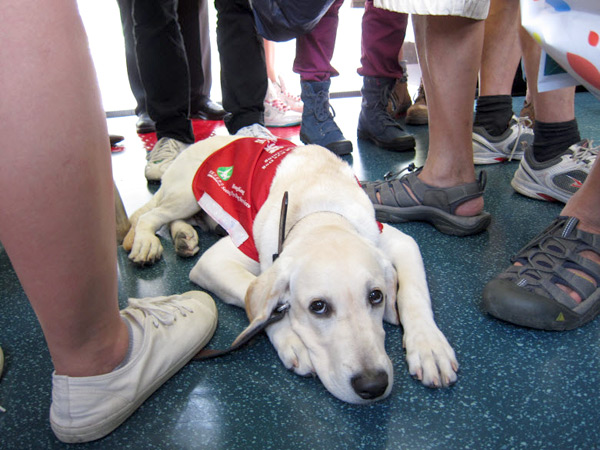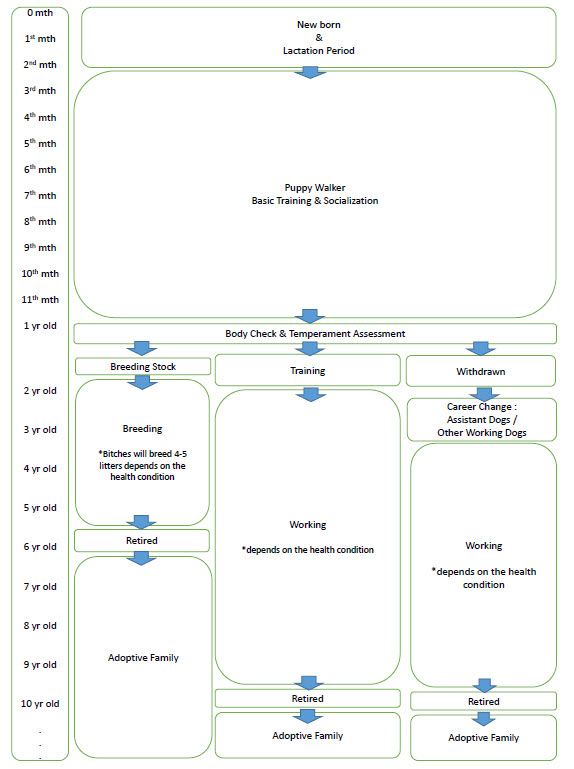導盲犬?『正向訓練知多D』???(響片訓練)
Knowledge
3 Don’ts and 1 Do ?
- Don’t disturb: Don’t make noises or gestures to catch the attention of the dog.
- Don’t pet: Don’t pet or touch the dog without permission from the handler.
- Don’t feed: Don’t offer food of any kind to the dogs.
- Do offer assistance: When you see a visually impaired user with her or his dog getting lost, do ask if the person needs your assistance. That is always helpful and appreciated.

Training
導盲犬?『正向訓練知多D』??(尋找目標物)
導盲犬?『正向訓練知多D』EP. 3 ??
Life Story

Regulations
- According to the Hong Kong Ordinances, Chapter 487 [the Disability Discrimination Ordinance]:Visually-impaired people including those accompanied with Seeing Eye Dogs can enter any public places (paid or unpaid areas).
Visually-impaired people including those accompanied with Seeing Eye Dogs can enter any public places (paid or unpaid areas).
Reference link: CAP 487 the Disability Discrimination Ordinance
- According to the Food Hygiene Code, Chapter 6, Miscellaneous 6.4 [Prohibition of Animals on Food Premise] :Dogs are prohibited to get onto food premises EXCEPT that the dog is served as a Seeing Eye Dog for a visually-impaired person;Reference
Dogs are prohibited to get onto food premises EXCEPT that the dog is served as a Seeing Eye Dog for a visually-impaired person;
Reference link:http://www.fehd.gov.hk/english/publications/code/code_summary.pdf
- According to the Hong Kong Ordinances, Chapter 167D [Dangerous Dogs Regulation] :
If a Seeing Eye Dog is not a kind of fighting dog and not classified as a known dangerous dog by magistrate’s order, the ordinance does not provide the dog has to be fitted with a muzzle. Fighting Dogs include:
- Any dog of the type known as the Pit Bull Terrier.
- Any dog of the type known as the Japanese Tosa.
- Any dog of the type known as the Dogo Argentino.
- Any dog of the type known as the Fila Braziliero.
- Any dog which is a cross-breed involving the breed of any dog of the type set out in any of the above sections.
Reference link: CAP 167D Dangerous Dogs Regulation
Seeing Eye Dog Guidelines
- A Seeing Eye Dogs or puppies will not defecate indoors because they will only do so with user’s instructions. Allowing Seeing Eye Dogs and puppies into malls will not get the place dirty.
- Seeing Eye Dogs and puppies are with stable temperament. They do not disturb other people nor bark at random.
- Allowing Seeing Eye Dogs and puppies into the malls enables the dogs to have socialization training which facilitates the dogs to adapt to human life. This is a great help to establish a barrier-free society.
- All staff has ID documents (including the name of the accompanied dog) and equipment for identification:
- Trainers / instructors + Seeing Eye Dog Puppy + red vest + harness
- Puppy walker / Seeing Eye Dog Handler + Seeing Eye Dog Puppy + red vest
- Users + Seeing Eye Dog + harness
- Our staff includes trainer, instructor, Seeing Eye Dog handler, puppy walker, and users. In fact, visually impaired person includes amblyopia and blindness. Both of them may bring along the Seeing Eye Dogs to public places. When the visually impaired people and their Seeing Eye Dogs enter the mall, front-line customer service representatives should provide necessary assistance.
- Generally, the visually impaired and their Seeing Eye Dogs do not require assistance as long as they can enter and leave the premises without limitation.
- When the visually impaired is wandering with hesitation in the mall, they may get lost. You may actively ask if they need any assistance in guiding the way. The customer service representatives should stand on the right hand side of the visually impaired and avoid contacting the Seeing Eye Dog.
- People who want to know and make contact with the Seeing Eye Dog should first seek permission from the user.
Emergency Measures
Should a user require the assistance of an ambulance in a public area, the Seeing Eye Dog should be handled in the following ways:
| The user is awake and able to hold the dog leash | The user is unconscious | |
| In the ambulance |
|
|
| In the hospital |
|
|







